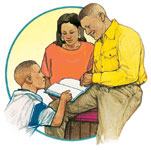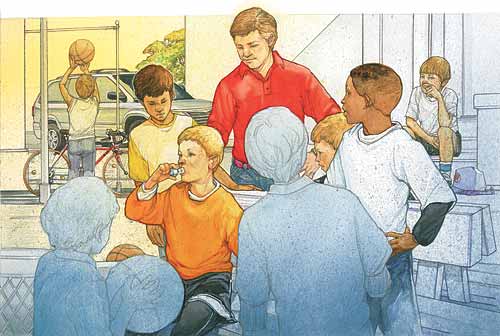
Helping Your Child Manage Asthma
By Kris Imherr
Illustration by Joel Snyder
Although one national health institute calls asthma "the most common chronic disease of childhood," there are definite steps a parent or significant adult can take to help a child control it.

Michael Marchiano has supportive buddies. "Sometimes my friends worry about me," the 10-year-old from Staten Island, N.Y., says. "Because when I play sports—I play basketball really hard—they tend to say: 'Sit out for a while.' Like, 'calm down.'"
His friends express concern because Michael has asthma, a disease affecting the air pathways of the lungs. Asthma left unchecked can deteriorate into a serious condition resulting in a struggle to breathe.
That struggle, an "asthma attack," is the airways' acute reaction to adverse stimuli. We all process disturbances in our breathing passages from such things as air pollution or the common cold, but people with asthma may be more sensitive and have a harder time clearing them away.
As an asthmatic's airways sense harm from one or more adverse stimuli, they may swell, become inflamed, and clog up as they start producing more mucus than normal. Muscles around the airways tighten. All this decreases airflow, making breathing difficult and necessitating medical intervention.
The Centers for Disease Control and Prevention (CDC), a federal health agency, recently reported that more than four million U.S. children younger than 18 had had an asthma attack within the prior 12 months. The same report said nine million U.S. children had been diagnosed with asthma at some time in their lives.
The figure represents 12 percent of the under-17 age group, with boys (14 percent) more likely than girls (10 percent) to receive that diagnosis.
That means that "in any given group of U.S. school-age kids—a Cub Scout pack, for example—two of every 20 are likely to currently have asthma," says Dr. Lani S. Wheeler, a Maryland-based public health pediatrician and member of the American Academy of Pediatrics.
Asthma prevalence and some of its adverse effects have climbed steadily for two decades. About 14 million days' of school absences each year are now attributed to the disease. The National Heart, Lung, and Blood Institute has labeled it the most common chronic, or persistent and recurring, disease of childhood.
Although there exists no close prospect for a definitive cure, Dr. William K. Dolen, vice president of the American College of Asthma, Allergies, and Immunology, says nearly all asthma can be controlled.
Key steps in helping your child manage asthma include the following:
Identify and acknowledge your child's asthma.
The path to control begins with diagnosis, which may not be easy, either in terms of labeling the disease or accepting it emotionally.
The culprits that may instigate or aggravate asthma are called "triggers." They include allergens—substances that cause allergic reactions—such as dust mites, pet hair, pollen, and certain foods, like peanuts or shellfish. Illnesses, such as respiratory infections and flu viruses; and irritants, such as air pollution, paints, perfumes, and tobacco smoke, can be triggers, too. So can conditions such as cold air, exercise, or stress.
Not only can asthma have many causes, it also can set off diverse reactions. "Symptoms vary, and some children start as infants, others at [age] 5, 8, or 16," says Sandra Fusco-Walker, outreach education coordinator for the Allergy and Asthma Network Mothers of Asthmatics (AANMA), a national nonprofit advocacy organization. All three of her children have asthma, and she points out that individuals in the same family may experience different symptoms.
That's true in Michael Marchiano's family, says his mother, Maria. When Michael starts to cough, especially at night, she says, "those are the early warning signs" that his asthma is giving him problems. But Robert, Michael's 7-year-old brother, "can go from being perfectly fine to an [asthma] attack before I can bat an eye."
Michael Marchiano was diagnosed as a baby, as was Benjamin (Boomer) Finkelstein of West Bloomfield, Mich. Boomer was not yet 18 months old when his mom, Carol, detected a wheeze that signaled asthma's onset. Boomer's pediatric allergist had already alerted Carol that asthma likely lay in his future.
Get educated and then take action.
Parents should educate themselves thoroughly about asthma. There are excellent guides for adults, books geared to children, Web sites for both, and a plethora of small and large help groups. (Most caution not to substitute general information for personalized medical counsel.)
Informed parents can take action by consulting doctors about control medicines that prevent attacks and quick-relief medicines that quell attacks. These parents will know how to identify their kids' triggers. They will modify their family's environment to eliminate triggers and change its routines to avoid them.
Put it in writing.
Dr. Wheeler also advises to "get a written asthma action plan from your health-care provider to share with your child's school, child-care providers, coaches, and Scout leaders."
"The plan lists written instructions on triggers, medications, emergency steps," and more, says Fusco-Walker, and helps people who come in contact with an asthmatic child ensure that his needs are met.
"Somebody who has significant asthma would need to have his asthma action plan updated at least yearly, and for somebody is who growing and who has difficult-to-control asthma, we look at their plan even every month or two," Dr. Dolen says.
Fusco-Walker also recommends keeping a diary. AANMA offers one called an AsthmaTracker, and the National Jewish Medical and Research Center has MyAsthma, a free, interactive, online version on their Web site, www.njc.org. A diary is a great tool, Fusco-Walker says, "because over time you can see a pattern to a child's asthma and may be able to pick out times or places where they have ongoing problems and address them."
Train the child to take control.
One of the most difficult challenges Carol Finkelstein says asthma initially presented "was getting a child who was not even 2 years old to take breathing treatments on a nebulizer," a machine that sprays a medicated mist through a mask fitted over the face. It was the last thing my son Boomer wanted, Finkelstein says, "and it takes a while for a child to learn, 'Oooh, if I do this, I start to feel better.'"
For many children, increasing responsibility for their own asthma care may be crucial to ongoing good health. Chances are, besides getting into a routine of taking their "meds," they'll need to learn to use a peak flow meter as well as a bronchodilator inhaler.
A small device that measures how fast air comes out of their lungs, the peak flow meter, used regularly, helps monitor how open the airways are. Used orally, an inhaler, a small canister that looks like a mini-air horn, sprays medicated mist in measured doses. Some children "pre-treat" themselves with an inhaler before playing sports. Many keep one handy to offer quick relief in case of an attack.
Sandra Fusco-Walker reinforces the importance of an asthmatic child's involvement in his own care by telling parents, "We can do whatever we want for our kids, but they grow up, and they leave home, and their asthma goes with them."
Freelance writer Kris Imherr lives in Dallas, Tex.
Important notice: This column is designed as an educational tool only. For specific medical advice, please consult your physician.
Some Common Symptoms of AsthmaCoughing. Often worse at night, making it hard to sleep, or early in the morning. Frequent coughing may be the only sign of asthma in a child. Wheezing. Whistling or squeaks that come with breathing. Chest tightness. The feeling that someone or something is sitting on or squeezing your chest. Shortness of breath. The feeling that you can't catch your breath. Faster breathing or noisy breathing. All these can stem from other illnesses, which is why it is important to consult a doctor. |
Asthma ResourcesAllergy and Asthma Network Mothers of Asthmatics, (800) 878-4403, www.aanma.org American Academy of Allergy, Asthma, and Immunology, (800) 822-2762, www.aaaai.org American College of Allergy, Asthma, and Immunology, www.allergy.mcg.edu American Lung Association, (800) LUNGUSA (586-4872), www.lungusa.org Asthma and Allergy Foundation of America, (800)-7-ASTHMA (727-8462), www.aafa.org National Asthma Education and Prevention Program, (301) 592-8573, www.nhlbi.nih.gov/about/naepp/index.htm National Center for Environmental Health, Centers for Disease Control and Prevention, (888) 232-6789, www.cdc.gov/nceh/airpollution/asthma/default.htm National Jewish Medical and Research Center, (800) 222-LUNG (5864), http://asthma.nationaljewish.org |
September 2004 Table of Contents
Copyright © 2004 by the Boy Scouts of America. All rights thereunder reserved; anything appearing in Scouting magazine or on its Web site may not be reprinted either wholly or in part without written permission. Because of freedom given authors, opinions may not reflect official concurrence.